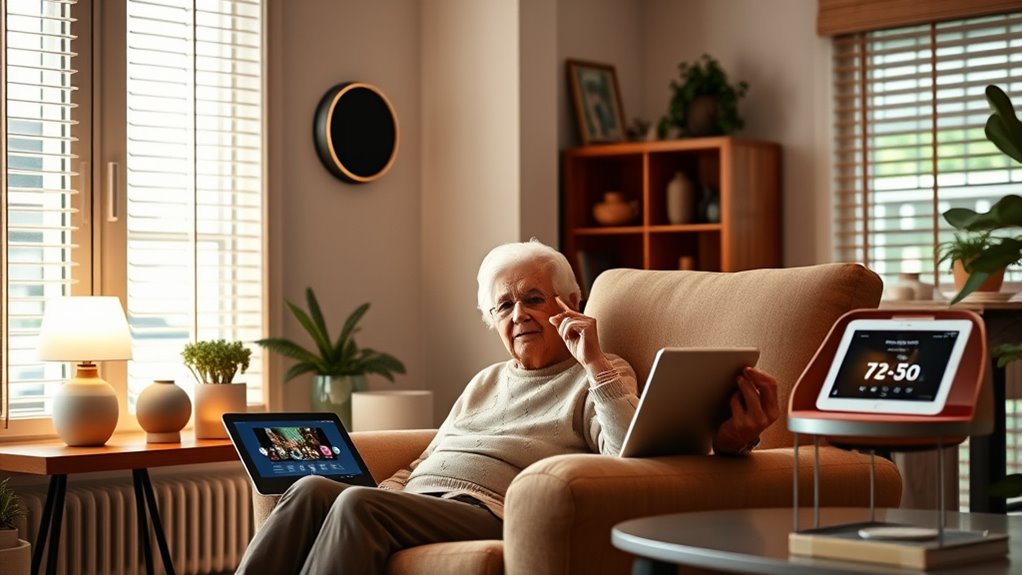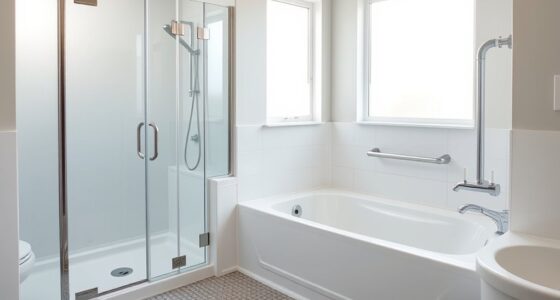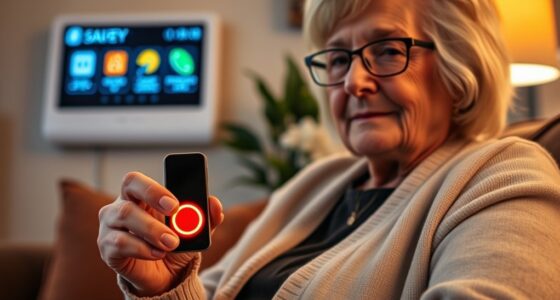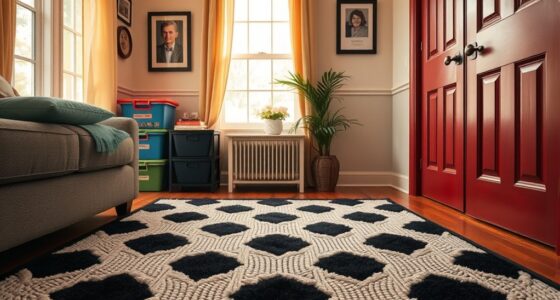Voice-controlled smart home technology helps you stay independent and safe by allowing you to manage lights, locks, thermostats, and appliances with simple voice commands. It also provides quick emergency alerts and automatic responses for added security, giving you peace of mind. You can easily automate bedtime routines, reducing reliance on switches or keys. Exploring further reveals how these devices can enhance your daily comfort and safety even more.
Key Takeaways
- Enables seniors to control lights, thermostats, locks, and appliances hands-free, promoting independence and ease of daily routines.
- Features emergency voice commands for instant alerts to family, caregivers, or emergency services, enhancing safety.
- Simplifies bedtime routines with single commands to automate lighting, locking doors, and adjusting temperature.
- Allows customization of alerts and calls for help, ensuring quick assistance during emergencies or falls.
- Integrates sound design and voice technology for clear prompts, improving accessibility for seniors with limited dexterity.

As technology advances, voice-controlled smart home devices are becoming a critical tool for seniors seeking independence and safety. These devices allow you to control lights, thermostats, locks, and even appliances with simple voice commands, making daily tasks easier and more manageable. They’re especially helpful when managing bedtime routines, as you can say, “Good night,” to turn off lights, lock doors, and set the thermostat to a comfortable temperature—all without leaving your bed. This seamless control helps create a calming, organized evening routine that promotes better sleep and peace of mind.
Beyond convenience, voice-controlled smart home tech plays an essential role in emergency situations. Many devices are equipped with emergency alerts that you can activate simply by speaking. If you fall or feel unwell, you can shout, “Help,” or “Emergency,” to instantly alert family members, caregivers, or emergency services. This quick access to assistance reduces response times and can be life-saving. Some systems even automatically send alerts if they detect unusual activity or a sudden fall, ensuring you’re always connected and protected.
Using voice commands for bedtime routines not only adds comfort but also enhances safety. You no longer need to fumble for switches or keys, which can be difficult if mobility is limited. Instead, you can set multiple routines with a single command, such as “Prepare for bed,” and the system can turn off the lights, lock the doors, and lower the blinds. These automated routines help you maintain a sense of independence, making it easier to stick to your nightly schedule without relying on others.
Emergency alerts are a key feature that provides reassurance for both you and your loved ones. With voice-activated emergency systems, you can call for help instantly, even if you’re unable to reach a phone or get out of bed. Many devices also allow you to customize alerts, so you can notify specific family members or caregivers if something’s wrong. This personalized approach ensures that someone is always aware of your needs, no matter the situation. Incorporating emergency response features can further enhance your safety and provide peace of mind.
In addition, Camper features can be integrated into smart home systems to enhance mobility and outdoor safety, offering a comprehensive approach to independence. Additionally, understanding building codes and zoning regulations is important to ensure compliance when setting up smart home features in your residence. Incorporating sound design principles, such as clear audio alerts and voice prompts, can improve the effectiveness of these systems and make them more user-friendly. Properly implementing voice technology integration can further streamline operations and improve overall user experience, especially for seniors who may have limited dexterity.
Frequently Asked Questions
How Secure Is Voice-Controlled Technology From Hacking?
You might wonder how secure voice-controlled technology is from hacking. While it offers convenience, there are privacy concerns since your voice data could be targeted. However, many devices use data encryption to protect your information. Stay cautious by regularly updating your device’s software and using strong, unique passwords. This way, you can enjoy the benefits while minimizing risks and safeguarding your privacy.
Can Seniors Customize Voice Commands Easily?
Imagine gently pressing a button on your device, then effortlessly speaking your favorite commands. You find it surprisingly easy to customize voice commands with a user-friendly setup that guides you step-by-step. Adjusting your smart home is simple, allowing you to tailor commands to fit your routines. With clear instructions, you’ll quickly personalize voice command customization, making your smart home feel truly yours without any stress or confusion.
What if the Voice Assistant Doesn’T Understand Accents?
If the voice assistant struggles with accent recognition, it can be frustrating, especially with language diversity. You should look for devices that support multiple accents and dialects, improving understanding. Many modern assistants are continuously updated to better recognize various accents, so keep your device’s software current. You can also try speaking slowly or using clearer commands to help with comprehension, making your experience smoother and more inclusive.
Are There Costs Associated With Installing Smart Home Tech?
When considering smart home tech, you’ll want to think about installation costs and ongoing maintenance. Installation costs vary depending on the system you choose and whether you hire professionals or do it yourself. Ongoing maintenance may include software updates, replacing batteries, or troubleshooting. While some devices are affordable, premium setups might require a larger initial investment. Planning ahead guarantees you’re prepared for both upfront costs and ongoing expenses.
How Does Voice Tech Integrate With Existing Home Devices?
Many believe voice tech seamlessly integrates with all home devices, but compatibility varies. You’ll need to check if your existing smart devices support voice command setup or if they require additional hubs or updates. To guarantee smooth operation, verify smart device compatibility beforehand. This way, you can confidently connect your devices, making voice control easy and efficient, especially for seniors who benefit from simplified technology management.
Conclusion
Embracing voice-controlled smart home technology can truly enhance your independence and safety. Did you know that nearly 80% of seniors who use voice assistants report feeling more confident managing daily tasks? By integrating this tech, you gain convenience and peace of mind, knowing help is just a voice command away. It’s a simple step toward staying connected and autonomous, ensuring you enjoy your home comfortably and securely for years to come.









